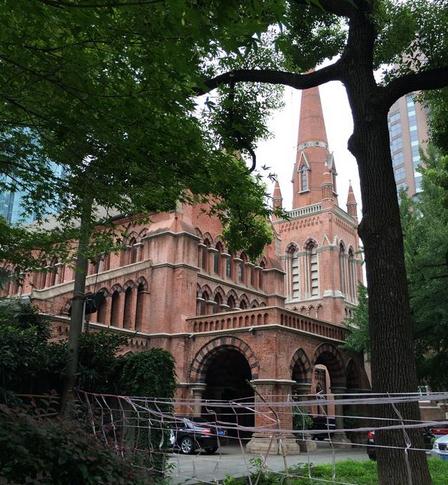

The first time that architect Zhang Ming stepped into the Holy Trinity Church was more than half a century ago. Now the 84-year-old woman, an architectural maestro, has completed a restoration of this oldest-surviving Christian church in Shanghai, which last month hosted its first service in decades and is scheduled to open in the near future.
"It was such an exquisite building," recalls Zhang, who surveyed the Huangpu District church when heading Shanghai's first research on modern historic buildings in the early 1960s.
"Bricks were so neatly and beautifully laid. Architectural details were abundant. I remember every seat had a Bible and a small staircase led up to the sermon stage. It's incredible that the church was supported by 8,000 wooden piles. It's a pity that I only took black-and-white photos," she says.
A 1902 book, "Shanghai By Night And Day," gave an account of the church's history. The earliest British community in Shanghai, about 100 residents who included only seven women, initially worshiped at the British Consulate General. Then "a church was built, so badly built that within a very short time, as the result of an abnormal rainstorm, the roof fell in, and the repairs ran into more money than the original structure."
Afterward, "the greatest Gothic designer of his day," Sir Gilbert Scott from the UK, was commissioned to draw plans for the new church, which was modified by local architect William Kidner.
Roman and Gothic in design, the church built in 1869 has a nave, two transepts, two aisles and a chancel. In 1875, it received a big honor from Queen Victoria and became the Cathedral of the Diocese of North China, which was directly under the supervision of the Archbishop of Canterbury.
"At that time it was a church of the highest rank in the Far East and also one of the most beautiful buildings in Shanghai," Tongji University professor Zheng Shiling says in his book "The Evolution of Shanghai Architecture in Modern Times."
The book also lists several masterpieces of architect Scott, ranging from St Giles Camberwell Church in London, Exeter College Oxford, the Foreign Office of London's White Hall to St Pancras Hotel and Station Block.
The colonnades, red bricks and the clock tower are three noteworthy characters of the church, according to Zhou Jin, a PhD researcher on Shanghai Christian architecture.
"Most early buildings in Shanghai's settlement were built in colonial veranda style, a form Westerners implanted from South Asia and later found unfit for Shanghai's weather. Trinity Church was a precious existing example of that style, after which local churches generally had 'one skin' with no colonnade surrounding it, no matter in Roman or Gothic styles," says Zhou, who admires the dazzling lights and shadows on the façade created by the colonnade that encircles the Trinity Church.
He also says the architect's use of red bricks was done "in a pure way," as even the arches and small architraves on the façade are made of red bricks instead of stones. That's why it was once called the "Red Church."
In 1893, a steep clock tower in Gothic style was added to the northeast side, which featured a big pointed roof in the middle with four smaller ones at the four corners.
Zhou regards it as a luxury to build an independent clock tower aside a church in downtown Shanghai because land prices were soaring so fast after the city opened port in 1843.
"In later years, clock towers were usually on both sides of the façade, tightly close to the side of the main church, or there was no clock tower at all," Zhou says. "The Trinity Church had secured a big site in very early times so it allowed ample space for erecting a clock tower in 1893."
He adds that even the small garden on the crossroads of Jiujiang and Jiangxi Roads today formerly belonged to the garden of the church.
Century-old church burns down in fire
2014-07-28Church served as focal point of life
2014-07-08Copyright ©1999-2018
Chinanews.com. All rights reserved.
Reproduction in whole or in part without permission is prohibited.